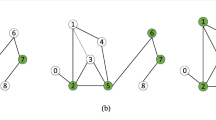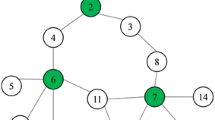Abstract
The minimum connected dominating set problem, a variant of the classical minimum dominating set problem, is a very significant NP-hard combinatorial optimization problem with a number of applications. To address this problem, a greedy randomized adaptive search procedure (GRASP) that incorporates a novel local search procedure based on greedy function and tabu strategy is proposed. Firstly, the greedy function is proposed to define the score of each vertex so that our algorithm could obtain different possible optimal solutions. Secondly, a tabu strategy is introduced to prevent the search trapping into the local minimum and avoid the cycling problems. The proposed algorithm is evaluated against several state-of-art algorithms on a large collection of benchmark instances. The experimental results prove that GRASP performs better than its competitors in most benchmark instances.




Similar content being viewed by others
Explore related subjects
Discover the latest articles, news and stories from top researchers in related subjects.References
Berge C (1973) Graphs and hypergraphs[M]. North-Holland Publishing Company, Amsterdam
Liu CL (1968) Introduction to combinatorial mathematics[M]. McGraw-Hill, New York
Di Benedetto CA (2010) Diffusion of innovation. Wiley, Chichester
Valente TW (1995) Network models of the diffusion of innovations. Hampton Press, Cresskill
Domingos P, Richardson M (2001) Mining the network value of customers. In: Proceedings of the seventh ACM SIGKDD international conference on knowledge discovery and data mining. ACM, pp 57–66
Goldenberg J, Libai B, Muller E (2001) Using complex systems analysis to advance marketing theory development: modeling heterogeneity effects on new product growth through stochastic cellular automata. Acad Mark Sci Rev 9(3):1–18
Asavathiratham C, Roy S, Lesieutre B et al (2001) The influence model. Control Syst IEEE 21(6):52–64
Cooper C, Klasing R, Zito M (2005) Lower bounds and algorithms for dominating sets in web graphs. Internet Math 2(3):275–300
Eubank S, Guclu H, Kumar VSA et al (2004) Modelling disease outbreaks in realistic urban social networks. Nature 429(6988):180–184
Stanley EA (2006) Social networks and mathematical modeling. Connections 27(1):43–49
Garey M, Johnson DS (1979) Computers and intractability, a guide to the theory of NP—completeness. Freeman, San Francisco
Ruan L, Du H, Jia X, Wu W, Li Y, Ko KI (2004) A greedy approximation for minimum connected dominating sets. Theor Comput Sci 329(1–3):325–330
Cheng X, Ding M, Chen D (2004) An approximation algorithm for connected dominating set in ad hoc networks. In: Proceedings of the international workshop on theoretical aspects of wireless ad hoc, sensor and peer-to-peer networks (TAWN)
Min M, Du H, Jia X, Huang CX, Huang SCH, Wu W (2006) Improving construction for connected dominating set with Steiner tree in wireless sensor networks. J Glob Optim 35(1):111–119
Guha S, Khuller S (1998) Approximation algorithms for connected dominating sets. Algorithmica 20(4):374–387
Butenko S, Cheng X, Oliveira C, Pardalos P (2004) A new heuristic for the minimum connected dominating set problem on ad hoc wireless networks. In: Butenko S (Ed) Recent developments in cooperative control and optimization. Kluwer Academic Publishers, New York, pp 61–73
Butenko S, Oliveira C, Pardalos P (2003) A new algorithm for the minimum connected dominating set problem on ad hoc wireless networks. In: CCCT’03. International Institute of Informatics and Systematics (IIIS), pp 39–44
Gendron B, Lucena A, da Cunha AS et al (2014) Benders decomposition, branch-and-cut, and hybrid algorithms for the minimum connected dominating set problem. INFORMS J Comput 26(4):645–657
Misra R, Mandal C (2010) Minimum connected dominating set using a collaborative cover heuristic for ad hoc sensor networks. IEEE Trans Parallel Distrib Syst 21(3):292–302
Morgan M, Grout V (2007) Metaheuristics for wireless network optimisation. In: The third advanced international conference on telecommunications, AICT 2007, p 15, May 2007
He H, Zhu Z, Makinen E (2009) A neural network model to minimize the connected dominating set for self-configuration of wireless sensor networks. IEEE Trans Neural Netw 20(6):973–982
Downey RG, Fellows MR, McCartin C, Rosamond FA (2008) Parameterized approximation of dominating set problems. Inf Process Lett 109(1):68–70
Jovanovic R, Tuba M (2013) Ant colony optimization algorithm with pheromone correction strategy for the minimum connected dominating set problem. Comput Sci Inf Syst 10(1):133–149
Nimisha TS, Ramalakshmi R (2015) Energy efficient connected dominating set construction using ant colony optimization technique in wireless sensor network. In: Innovations in information, embedded and communication systems (ICIIECS), 2015 international conference on IEEE, 2015, pp 1–5
Feo TA, Resende MGC (1989) A probabilistic heuristic for a computationally difficult set covering problem. Oper Res Lett 8:67–71
Feo TA, Resende MGC (1995) Greedy randomized adaptive search procedures. J Glob Optim 6:109–133
Resende MGC, Ribeiro CC (2002) Greedy randomized adaptive search procedures. In: Glover F, Kochenberger G (eds) Handbook of metaheuristics. Kluwer Academic Publishers, Norwell, pp 219–249
Resende MGC, Ribeiro CC (2010) Greedy randomized adaptive search procedures: advances and applications. In: Gendreau M, Potvin J-Y (eds) Handbook of metaheuristics, 2nd edn. Springer, Berlin
Festa P, Resende MGC (2002) GRASP: an annotated bibliography. In: Ribeiro CC, Hansen P (eds) Essays and surveys on metaheuristics. Kluwer Academic Publishers, Boston, pp 325–367
Festa P, Resende MGC (2009) An annotated bibliography of GRASP—Part I: algorithms. Int Trans Oper Res 16:1–24
Festa P, Resende MGC (2009) An annotated bibliography of GRASP—Part II: applications. Int Trans Oper Res 16(2):131–172
Wang Y, Li R, Zhou Y, Yin M (2016) A path cost-based GRASP for minimum independent dominating set problem. Neural Comput Appl. doi:10.1007/s00521-016-2324-6
Ho CK, Singh YP, Ewe HT (2006) An enhanced ant colony optimization metaheuristic for the minimum dominating set problem. Appl Artif Intell 20(10):881–903
Zhou Y, Zhang H, Li R, Wang J (2016) Two local search algorithms for partition vertex cover problem. J Comput Theor Nanosci 13:743–751
Li X, Zhang J, Yin M (2014) Animal migration optimization: an optimization algorithm inspired by animal migration behavior. Neural Comput Appl 24(7–8):1867–1877
Li X, Wang J, Yin M (2014) Enhancing the performance of cuckoo search algorithm using orthogonal learning method. Neural Comput Appl 24(6):1233–1247
Li X, Yin M (2014) Self adaptive constrained Artificial Bee Colony for constrained numerical optimization. Neural Comput Appl 24(3–4):723–734
Wang Y, Cai S, Yin M (2016) Two efficient local search algorithms for maximum weight clique problem. In: AAAI2016
Wang Y, Yin M, Ouyang D, Zhang L (2016) A novel local search algorithm with configuration checking and scoring mechanism for the set k-covering problem. Int Trans Oper Res. doi:10.1111/itor.12280
Glover F (1989) Tabu search—part I. ORSA J Comput 1(3):190–206
Li R, Hu S, Wang Y, Yin M (2016) A local search algorithm with tabu strategy and perturbation mechanism for generalized vertex cover problem. Neural Comput Appl. doi:10.1007/s00521-015-2172-9
Zhang X, Li X, Wang J (2016) Local search algorithm with path relinking for single batch-processing machine scheduling problem. Neural Comput Appl. doi:10.1007/s00521-016-2339-z
Li R, Hu S, Wang J (2015) The community structure of the constraint satisfaction problem instances of model RB. J Comput Theor Nanosci 12:6088–6093
Acknowledgments
This work was supported in part by National Natural Science Foundation of China under Grant Nos. (61403077, 61402070, 61403076, 61370156) and Program for New Century Excellent Talents in University (NCET-13-0724).
Author information
Authors and Affiliations
Corresponding author
Rights and permissions
About this article
Cite this article
Li, R., Hu, S., Gao, J. et al. GRASP for connected dominating set problems. Neural Comput & Applic 28 (Suppl 1), 1059–1067 (2017). https://doi.org/10.1007/s00521-016-2429-y
Received:
Accepted:
Published:
Issue Date:
DOI: https://doi.org/10.1007/s00521-016-2429-y




